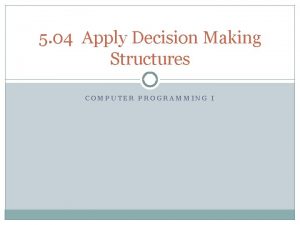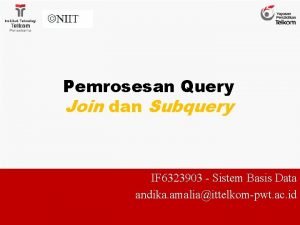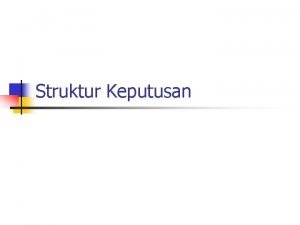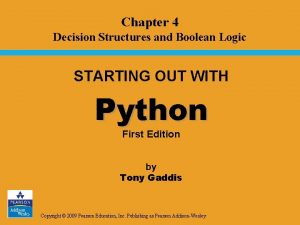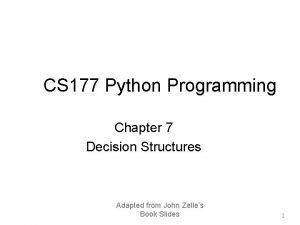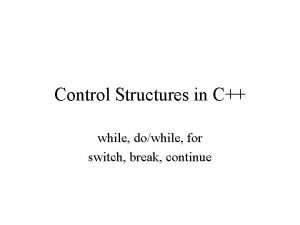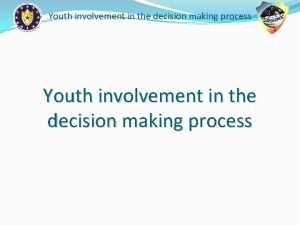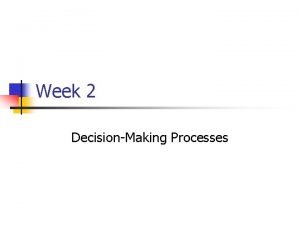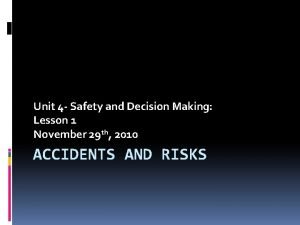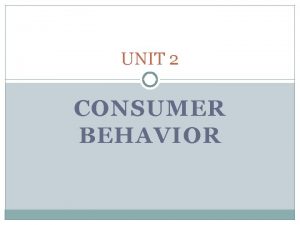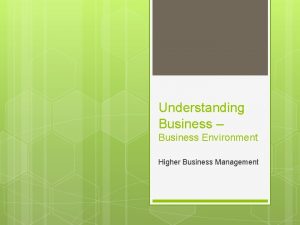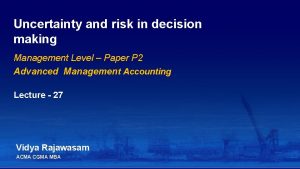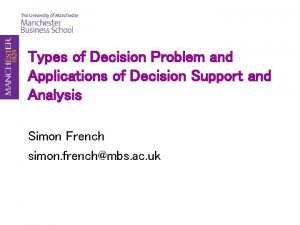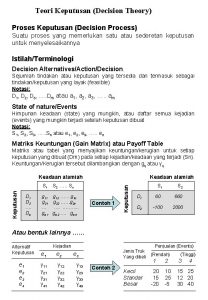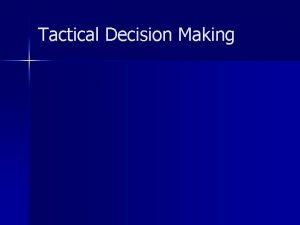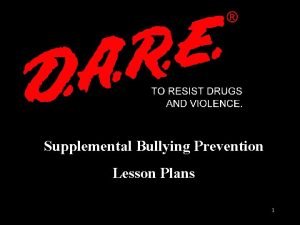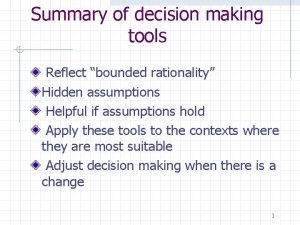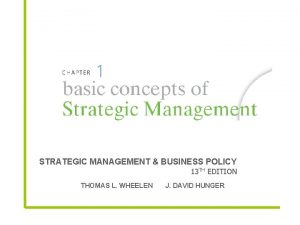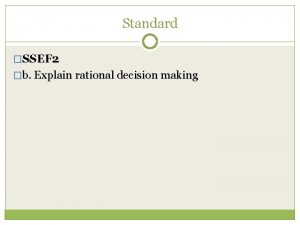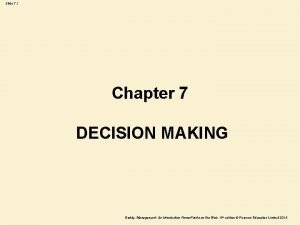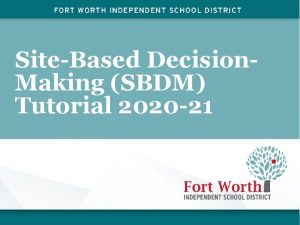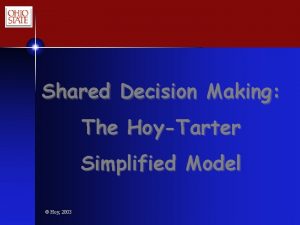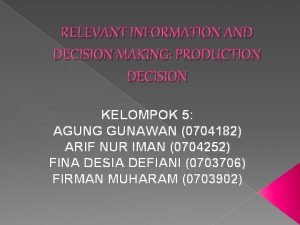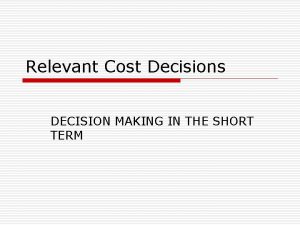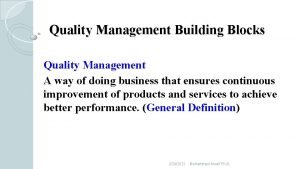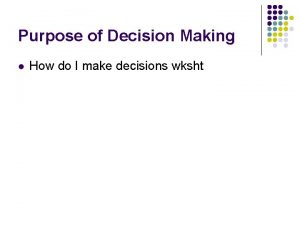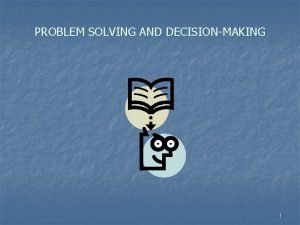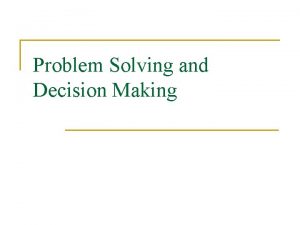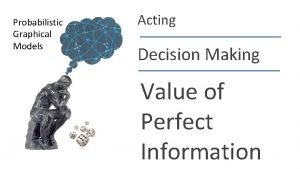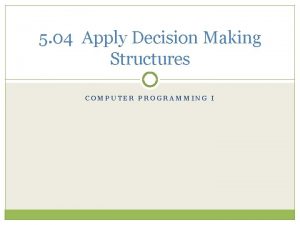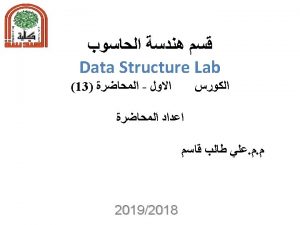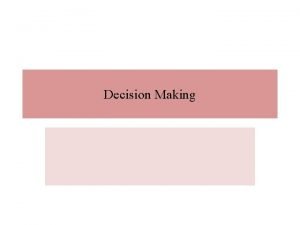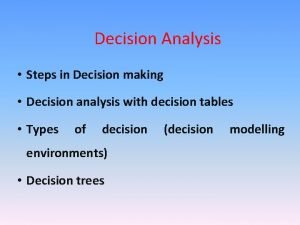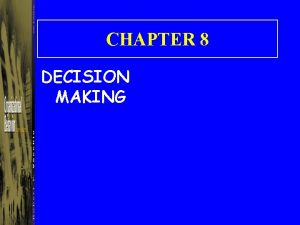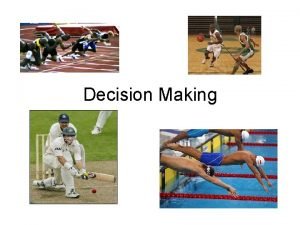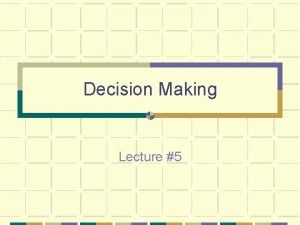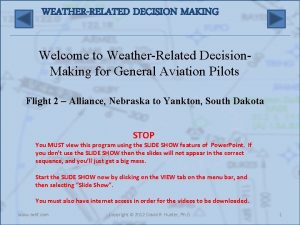5 04 Apply Decision Making Structures COMPUTER PROGRAMMING










































- Slides: 42

5. 04 Apply Decision Making Structures COMPUTER PROGRAMMING I

Objective/Essential Standard �Essential Standard: 5. 00 - Apply Programming and Conditional Logic �Indicator: 5. 04 Apply decision-making structures. (3%)

What is a decision? �Decisions are made by humans hundreds of times a day. �Computers can make simple decisions also. �What are some decisions you made today so far?

Boolean Logic �Remember, from the previous section Boolean logic? (Ex: int. Num = 5) �Computers use it to make decisions! �There are only two answers: TRUE or FALSE �Computers do not know about Maybe!

The If Decision Structure

Decisions… Decisions �So when you got up this morning what did you do? This is a decision. Let’s put it in computer terms. �IF the sun is out then I will walk to school

The If…Then Statement If…Then is a decision structure that executes a set of statements when a condition is true. Form: If condition Then TStatements End If

The If…Then Statement �IF the sun is out (question) THEN I will walk to school. �Remember the computer uses Boolean logic (T/F). So either the sun is out (true) or ANY other state (false). No maybes or in-betweens. �When the question is True, the statements after THEN (and down to ENDIF) execute. They are skipped if the question is False.

IF. . THEN. . ELSE Statement �In Visual Studio we use the IF. . THEN. . ELSE statement to tell the computer we want it to make a decision. �For example T F If a = b then c= 10 Else c=13 End If

Use of the ELSE �Else is optional- if omitted and the “question” is false no action is taken. �If ELSE is used, the statements after the ELSE will execute if the “question” is NOT true (Boolean FALSE)

Nested If…Then…Else Statements If…Then…Else statement within an If…Then…Else statement is called Nested. Example: If int. Num = 10 Then T lbl. Msg. text = “Ten” Me. Else If Int. Num > 10 Then Me. lbl. Msg. text = “More than 10” T Else F Me. lbl. Msg. text = “Less than 10” F End If

The If…Then…Else. If Statement �An IF statement can have multiple else statements- each one a new question or condition to check. �Also called an Else. If Ladder �The computer executes the statements below the first (or only) true condition and immediately exits the whole statement (ignores anything below the true statements).

The If…Then…Else. If Statement �Used to decide among three or more actions �Form: If condition Then Statements Else. If condition Then Statements … Else Statements End If �Last Else clause is optional – executes when no True above.

If…Then…Else. If Example If a = b Then c = 10 Else. If a > b Then c = 14 Else. If a < b Then c = 16 Else c = 12 End If

If…Then…Else. If Example #2 If str. Student. Class = “Senior” Then lbl. Answer. Text = “Seniors - start 1 hour late Fri” Else. If str. Student. Class = “Junior” Then lbl. Answer. Text = “Juniors - start 30 min late Fri” Else. If str. Student. Class = “Sophomore” Then lbl. Answer. Text = “Sophomores - start on time Fri” Else. If str. Student. Class = “Freshman” Then lbl. Answer. Text = “Freshmen - start 15 min early Fri” End If

The Select Decision Structure

Select Case Decision �Another way to make a decision is a select case statement. �This statement is used instead of multiple else if statements. �The computer again executes the first (or only) true statement and ignores the rest of the statement.

Select Case Decision �Decision structure that uses the result of an expression to determine which block of code to execute. �Form Example Select Case expression Select Case int. Score Case value Case 0, 10 Statements … … Case Else Statements End Select End Case

Select Case � Expression must evaluate to a built-in data type. Integer, Double, Character, String… � There can be multiple Case clauses. � Case Else clause is optional � Value type should match the expression type a single value, � a list separated by commas, or � Case 2 Case 1, 2, 3 a range separated by the keyword To. � Case 1 To 5 and can be

Case Is �Compares the result of an expression to a range of values when a relational operator is part of the value. �Must use Case Is with relational operators. �Example: Case Is < 10

Select Case Example Select Case int. Grades Case 100 str. Grade= “A+” Case 90 To 99 str. Grade= “A” Case 80 To 89 str. Grade=“B” Case 70 To 79 str. Grade=“C” Case 60 To 69 str. Grade=“D” Case Is < 60 str. Grade=“F” Else Messagebox. show(“Please input a valid number!”) End Select

If. . Then vs. Select Case �In most cases If. . Then is good for a single decision and a Select Case (or If Elseif) is correct to use when there are multiple possible answers with only one correct answer. � In the following example, remember the. Checked property of a radiobutton holds the values True or False! � A statement such as Add. Machine() is a block of code called a Function/Method that runs when its name is executed (like the Convert. To. Double(. . ) Function). � We will be writing them soon!

Which Radio Button is Clicked? Select Case True Case rad. Add. Checked Add. Machine() Case rad. Multiply. Checked Multiple. Machine() Case rad. Division. Checked Division. Machine() Case Else Messagebox. Show(“Pick a button!”) End Select

Sample Program �Write a program that allows the user to input a number. �The computer should tell the user if that number is smaller, greater or equal to 15.

Sample Program Solution Private Sub btn. Submit_Click(By. Val sender As System. Object, By. Val e As System. Event. Args) Handles btn. Submit. Click Dim number As Integer Try number = Convert. To. Int 32(txt. Number. Text) If number = 15 Then Message. Box. Show("The number is 15") Else. If number < 15 Then Message. Box. Show("The number is less than 15") Else. If number > 15 Then Message. Box. Show("The number is greater than 15") End If Catch ex As Exception Message. Box. Show(“Enter a numeric value”) End Try End Sub

Compound Boolean Expressions

Logical Operators �Logical Operators are used to create compound Boolean expressions. �Use logical operators And or Or to form a Boolean expression. �Logical operators join two expressions to create an expression that evaluates to either True or False. �Third operator is Not. �The order of precedence is Not, then And, then Or.

Compound Boolean Expressions �Use to check multiple values in a single statement. �Compound expressions resolve to a single True or False. �For example: If int. Num 1 = 15 And int. Num 2 > 2 Then statements End If

Compound Boolean Expressions - AND �T AND T evaluates to T �T AND F evaluates to F �When using And or & with IF, both (all) conditions MUST be true for the entire IF (or else if) question to evaluate to true. If number < 15 & number > 5 Then … �If the number is not less than 15 AND greater than 5 this statement is false.

Compound Boolean Expressions - OR � If number < 15 Or number > 5 Then Statements End If �Now if any one of the conditions are true, the statement evaluates to true. �T Or F evaluates to T �A truth table shows the possible outcomes of the Boolean Expressions.

And Truth Table Expression 1 And Expression 2 Expression 1 Expression 2 Boolean Expression True False True False

Or Truth Table Expression 1 Or Expression 2 Expression 1 Expression 2 Boolean Expression True True False False

Advanced If Statements

Short Circuiting � VB provides a way to “short circuit” long compound IF statements. The computer looks at the first statement and uses that information to decide if it needs to look at the rest of the statement. � And. Also If int. Num 1 > 0 And. Also int. Num 2 > 0 Then So if in. Num 1 is not greater than 0 the first Boolean expression is false and the computer does not waste time looking at num 2. � Or. Else If int. Num 1 > 0 Or. Else int. Num 2 > 0 Then If int. Num 1 is greater than 0 there is no need to check int. Num 2 because the first Boolean expression is true.

Using IF in Assignment Statements �An IF can also be used in assignment statements to set the value of a variable. �Example: Dim var. Name As Data Type = If(comparison, value if true, value if false) �Example: 'Assign a value to the string str. Name based on the comparison given. Dim str. Name As String = If(a < b, "Less than 10", "Greater than 10")

Randomizing a Number

Randomizing a Number �To generate a random integer, we can use the System Random class. �First create your Random Number Generator Dim gen As New System. Random() �You create the name (gen, num. Gen, …) to match the purpose of the generator. �Use the next or next. Double methods to generate the random numbers.

Randomizing a Number �Next. Double Returns a random number between 0. 0 and 1. 0. Example: dbl. Rnd. Num = gen. Next. Double • Generates a number between 0. 0 and up to, but not including 1. 0+ �Next Returns a nonnegative random number between 0 and the Max. Value (2, 147, 483, 647) Example: int. Rnd. Num = gen. Next • Generates a number between 0 and up to, but not including 2, 147, 483, 647

Randomizing a Number �Next (Int 32) Returns a nonnegative random number less than the specified maximum Example: int. Rnd. Num = gen. Next(10) • Generates a number from 0 and up to (but not including) 10 �Next (Int 32, Int 32) Returns a random number within a specified range Example: int. Rnd. Num = gen. Next(0, 50) • Generates a number from 0 and up to (but not including) 50

Random Numbers Example

Vocabulary & Code �Logical Operators �Compound Boolean Expression �Truth Table �Short Circuiting �If. . Then. . Else. If �Select. . Case �If. . And. Also �If. . Or. Else

Conclusion �This Power. Point provided an overview of decision making statements in Visual Studio. �For more information on Decision Statements http: //msdn. microsoft. com/enus/library/752 y 8 abs(v=vs. 100). aspx http: //msdn. microsoft. com/enus/library/cy 37 t 14 y(v=vs. 100). aspx �For more information on Random http: //msdn. microsoft. com/enus/library/system. random. aspx
 Decision making in computer programming
Decision making in computer programming No decision snap decision responsible decision
No decision snap decision responsible decision Financial management process
Financial management process Cross apply vs outer apply
Cross apply vs outer apply Struktur keputusan
Struktur keputusan Function of homologous structure
Function of homologous structure Nested decision structures in python
Nested decision structures in python Two way decision python
Two way decision python Control structures in c
Control structures in c Decision tree and decision table
Decision tree and decision table Involvement decision making
Involvement decision making Nasw code of ethics
Nasw code of ethics Systematic decision making process
Systematic decision making process What doing our country
What doing our country Mamdm
Mamdm Using functions in models and decision making
Using functions in models and decision making Paced decision making
Paced decision making Unit 4 lesson 1 decision making
Unit 4 lesson 1 decision making Decision making to improve marketing performance
Decision making to improve marketing performance Types of decision making
Types of decision making External factors higher business
External factors higher business Contribution payoff table
Contribution payoff table Decision categories
Decision categories What are the roles of marketing research
What are the roles of marketing research Critical decision making model police
Critical decision making model police Decision theory adalah
Decision theory adalah Tactical decision making adalah
Tactical decision making adalah What is the dare decision making model
What is the dare decision making model Bounded rationality
Bounded rationality Mintzberg's modes of strategic decision making
Mintzberg's modes of strategic decision making Paced decision making
Paced decision making Chapter 6 prices and decision making assessment answers
Chapter 6 prices and decision making assessment answers Decision making conditions
Decision making conditions Sbdm roles and responsibilities
Sbdm roles and responsibilities Hoy model
Hoy model Decision making and relevant information
Decision making and relevant information 5 step decision making process
5 step decision making process Decision making in healthcare
Decision making in healthcare Abcde decision making model
Abcde decision making model Decision making in psychology
Decision making in psychology Best books on problem solving and decision making
Best books on problem solving and decision making Individual and group decision making
Individual and group decision making What graphical model is appropriate for decision-making?
What graphical model is appropriate for decision-making?
